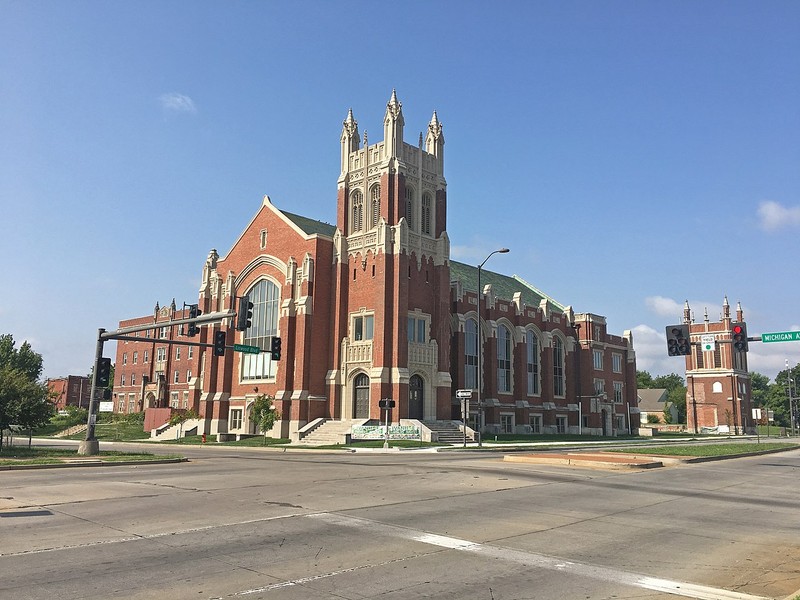Linwood Presbyterian Church
Introduction
Text-to-speech Audio
The former Linwood Presbyterian Church was built in 1923 and although it is no longer a church, it remains an important religious, social, and architectural landmark in Kansas City. It was home to a Presbyterian congregation established in 1889 that merged with Linwood United Methodist Church in 1975. Linwood Presbyterian was dedicated to providing a variety of social services to the community, including helping women who were recuperating from medical treatment or overwork. To serve these women, the congregation built a four-story structure next to the church in 1931 called the Home for Convalescent Employed Women. In terms of design, the church is an excellent example of large-scale Gothic Revival architecture. Notable features include a three-story tower with a crenellated parapet, a large Gothic window on the north façade, buttresses, and extensive decorative terra cotta elements. The church and former women's home were added to the National Register Historic Places in 2012.
Images
Built in 1923, Linwood Presbyterian Church is a fine example of Gothic Revival architecture. It was home to a congregation founded in 1889 that provided a variety of social services for several decades, including those that benefited women.

Backstory and Context
Text-to-speech Audio
A small group of nineteen Presbyterians established the church in 1889. They first met in April in a schoolhouse that once stood where the present church now stands and were granted permission to form the congregation in October. They built a wood-frame church on the southwest corner of the block that was completed in January 1891. The congregation grew in the next decade, which coincided with the increasing population of the city. Within a half mile of the church, 1,100 homes were built by 1900 and church membership grew from 107 in 1897 to 300 by 1902. This growth prompted the construction of the second church in late 1904 (the first church was purchased by another congregation and relocated). It was expanded in 1909 and a parish house with a tower was built just to the south that year as well. Membership continued to rise in the coming years which resulted in the construction of the present church in 1923. At that point there were 2,100 members. The previous church was used for classroom, program and community space.
The congregation began providing services to women in the summer of 1912. They erected a large tent nearby where women could rest between July to September. Over the next four years, around 200 women recuperated in the tent. In 1916, the congregation received a nearby house as a donation for the women but this was a temporary arrangement. After a permanent home was not found, the congregation ended its women's services and started to help handicapped children instead, opening the Linwood Presbyterian Home and School for Crippled Children (disabled girls) in 1917. It operated until 1929 when the school district started to admit disabled girls. Two years later, the congregation decided to revive its women's services and built the home for women. It had space for 43 women who usually stayed a week to ten days.
In the 1950s, the need for convalescent care began to decrease as hospitals started offering this type of service (insurance companies started offering hospitalization insurance as well). At the same time, however, elderly women began to need housing and as a result, the home was converted into a retirement residence in the 1960s. It closed in 1967 and was used for church and community programs. In 1968 it became known as the Linwood Center.
After World War II, the size of the congregation began to decline as the mostly white congregation moved to the suburbs. Mirroring similar trends in Kansas City and other communities, white families moved from the area in larger numbers as more African American families moved into the neighborhood. By 1957, around two-thirds of the students at the Linwood School were African American. That year, the church opened a nursery school to help working parents in the neighborhood. Some members of the congregation hoped to attract African American members while many others moved and joined other churches in their new neighborhoods, and the congregation remained nearly all-white until 1964. Although membership was declining, the congregation started offering other social services including a food and clothing pantry, employment and housing assistance, a baby clinic, a methadone clinic, tutoring, and G.E.D. courses.
It was clear by the mid-1970s that the congregation, which had just 206 members, could no longer support itself. As noted above, the congregation merged with Linwood United Methodist Church in 1975. The last service at Linwood Presbyterian occurred on May 25. A funeral home bought the church in the late 1970s but the cost of using the substantial building proved too much. In 1999, all of the buildings except the church, the former school (originally the women's home), and the tower of the 1909 church were torn down. The former church has served as the home of several non-profits in recent years.
Sources
Ottesen, Kristen. "Linwood Presbyterian Church and Home for Convalescent Employed Women." National Park Service - National Register of Historic Places Nomination Form. August 7, 2012. https://mostateparks.com/sites/mostateparks/files/Linwood%20Presbyterian%20Church%20and%20Home%20for%20Convalescent%20Employed%20Women.pdf.
Wikimedia Commons: https://commons.wikimedia.org/wiki/File:Linwood_Presbyterian_Church_and_Home_for_Convalescent_Employed_Women_KCMO.jpg
